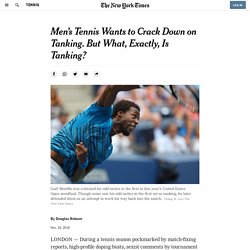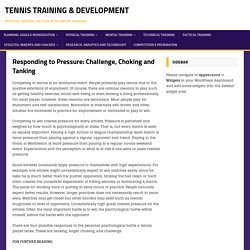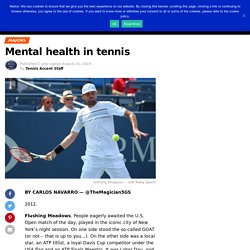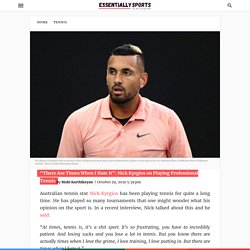Zoom
Trash
Related: Ethics Topics
- Ethics Theories
- Lectures
- Feminisme
- Histoire 2
- philo
- Politique / Socio
- bioethique
- Religious Freedom
- Education
- Enterprise

Men’s Tennis Wants to Crack Down on Tanking. But What, Exactly, Is Tanking? LONDON — During a tennis season pockmarked by match-fixing reports, high-profile doping busts, sexist comments by tournament directors and superstars sidelined by injuries, tanking would seem to be low on the list of priorities.

Yet with only the ATP World Tour Finals and the Davis Cup final between Croatia and Argentina left on the calendar, a deliberate lack of effort on the part of players has emerged as a pressing topic. “It’s something that we’re looking at very closely,” said Chris Kermode, the ATP’s chief executive. ATP officials are grappling with the knotty issue because some of the sport’s up-and-coming male stars have been perceived to be thumbing their noses at the game.
The talented but volatile Nick Kyrgios was suspended last month for disrespecting fans, his opponents and the sport. Nick Kyrgios: talent to burn: Five short pieces about one of tennis’s most misunderstood players. 1.

Most professional athletes are obsessed with winning, or at least with not losing. This fixation almost always predates them becoming a professional, and sometimes even comes before playing serious sport. Responding to Pressure: Challenge, Choking and Tanking – Tennis Training & Development. Competing in tennis is an emotional event.

People primarily play tennis due to the positive emotions of enjoyment. Of course, there are rational reasons to play such as getting healthy exercise, social well-being or even making a living professionally. Mental health in tennis - Tennis with an Accent. BY CARLOS NAVARRO — @TheMagician5GS Flushing Meadows.

People eagerly awaited the U.S. Open match of the day, played in the iconic city of New York’s night session. On one side stood the so-called GOAT (or not – that is up to you…). On the other side was a local star, an ATP titlist, a loyal Davis Cup competitor under the USA flag and an ATP Finals Maestro. "There Are Times When I Hate It": Nick Kyrgios on Playing Professional Tennis - EssentiallySports. Australian tennis star Nick Kyrgios has been playing tennis for quite a long time.

He has played so many tournaments that one might wonder what his opinion on the sport is. In a recent interview, Nick talked about this and he said: “At times, tennis is, it’s a shit sport. It’s so frustrating, you have to incredibly patient. And losing sucks and you lose a lot in tennis. Our Performance Psychologists - Meet The Condor Performance Team. At Condor Performance we currently use the services and expertise of a number of sport psychologists and performance psychologists located in a variety of different locations.

Our stringent selection process means that we believe they are all exceptional mental coaches. But we’ll let you to decide that on your own! Responding to Pressure: Challenge, Choking and Tanking – Tennis Training & Development. About me — Douglas Robson. Men's tennis wants to crack down on tanking. But what exactly is tanking? LONDON — During a tennis season pockmarked by match-fixing reports, high-profile doping busts, sexist comments by tournament directors and superstars sidelined by injuries, tanking would seem to be low on the list of priorities.

Yet with the ATP World Tour Finals title match Sunday and the Davis Cup final between Croatia and Argentina the only thing left on the calendar after that, a deliberate lack of effort on the part of players has emerged as a pressing topic. "It's something that we're looking at very closely," said Chris Kermode, the ATP's chief executive. Wimbledon fines Bernard Tomic more than $80,000 for first-round loss to Jo-Wilfried Tsonga. Players have rallied around Bernard Tomic after the Australian was fined his entire first-round prize money of more than $80,000 by Wimbledon officials for not playing up to the "required professional standards" in his listless first-round defeat.

Key points: Bernard Tomic lost to Jo-Wilfried Tsonga in just 58 minutes in their first-round matchTomic admitted he "played pretty bad" in the straight-sets defeat to TsongaHe has been fined before at Wimbledon following a loss in the 2017 tournament. Gender and Religion - Anthropology. There are several interdisciplinary readers that introduce the feminist study of religion (Juschka 2001) and the study of gender and religion in general (compare Boisvert and Daniel-Hughes 2017, Castelli 2001, Franzmann 2000).

Ortner and Whitehead 1981 provides an introduction to the study of gender within cultural systems, including religion. There are also several texts introducing readers to specific topics within the study of gender and religion. Religion in Australia: What are the Implications of 'None' being the New Normal? - ABC Religion & Ethics. Gary Bouma is Emeritus Professor of Sociology and UNESCO Chair in Interreligious and Intercultural Relations - Asia Pacific, Monash University.

According to the 2016 census, those declaring that they have "no religion" increased to just over 30%. The "nones" (as they are sometimes called) are the most numerous response category - more numerous than Catholics, in every generation until those over 70. Jews, Lutherans and Baptists have distributions similar to Anglicans. Hindus and Sikhs - who are now more numerous than Jews - have profiles more like Muslims mostly due to recent patterns of migration. The numbers and percentage declaring that they have "no religion" are most likely to continue to increase. How no religion became the most common religion in Australia. Of all the topics in the Census, religion seems to be the one that generates the most discussion. The Census is the only reputable source of data on religion in Australia, but it’s also the only optional question on the Census form. In the 2016 Census, the ABS made an important change to the religion question on the Census form, placing the option for “no religion” at the top of the answers.
Biomechanics - What It Is And Why It's Important. What is biomechanics? Why is it important for tennis and sport in general? How will it help improve your game and overall wellbeing? These are a few of the questions I’ll be answering in this primer on sports biomechanics…